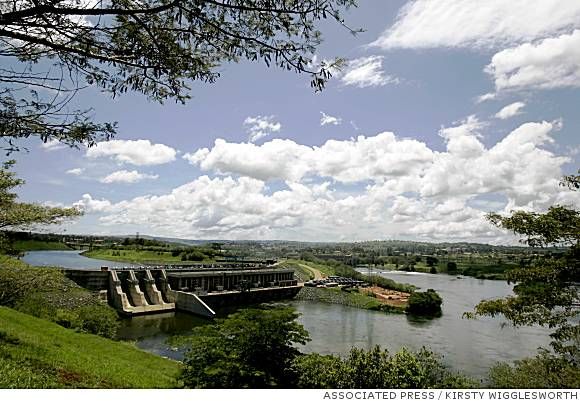As the morning sky lightens, the sound of machetes hacking through thick grass echoes along the lake's coastline. Fishermen, stripped to their underwear in the already stifling heat, are looking for silvery baby fish along the shoreline in defiance of laws against taking them in breeding grounds.
Lake Victoria, the world's largest tropical lake at 26,560 square miles and the second-largest freshwater lake in the world, is losing water at an alarming rate - at least six feet in the past four years. As a result, the waterway may soon join the list of dying lakes, some ecologists say.
The reasons are varied: rising temperatures, invasive species, hydroelectric dams, and about 30 million fishermen and dirt farmers from Kenya, Tanzania and Uganda who eke out a living from the lake and use it as their primary source of water.
"When the water goes down here, we have to follow the fish" into deeper waters, said fisherman Idi Obiero. "That's the only way you can get enough to feed your family."
Obiero's family has fished here for generations, and the lake feeds his two wives, eight children and nine grandchildren. It has always been a hard living, he says, with long hours in the hot sun and fluctuating catches, but the past few years have been especially rough.
Fish vanishing
The once-abundant iridescent tilapia and Nile perch are slowly disappearing from the Kenyan side. The Nile perch, introduced in the 1950s to increase fish yields, became a predator of several indigenous species such as the striped haplochromis.
And on top of all this, the climate is changing.
"Sometimes we just fish naked because it's so hot," Obiero said after catching a single catfish one morning. "When I was growing up it wasn't like this - there was plenty of rain."
However, a 2006 study by Berkeley's International Rivers places much of the blame for the lake's woes on dam projects by Uganda.
The Kiira Dam, built in 1999 alongside the 1954 Owen Falls Dam, uses Lake Victoria's waters to generate power for Ugandan residents and export energy to neighboring nations. Both dams operate at the source of the Nile River, where it flows out of Lake Victoria.
More water from lake
Because the Kiira Dam has produced less energy than expected, its officials are drawing more water from the lake, according to Frank Muramuzi, the director of Uganda's National Association of Professional Environmentalists.
"There weren't enough comprehensive studies done, there just isn't enough water available," said Muramuzi.
Nevertheless, Uganda began construction on yet another hydroelectric project last year - the $860 million Bujagali Dam. Although this project is designed to re-use water flowing out through the two existing dams, International Rivers criticizes it for relying on overly optimistic projections of its impact on Lake Victoria.
The project "ignores the true damage done to Lake Victoria by the existing dams and follows with a selective and optimistic view of current lake levels and possible climate change impacts," wrote hydrologist Daniel Kull in a 2006 study on the impact of dams in the Lake Victoria region for International Rivers.
Meanwhile, receding waters have raised tensions between the lake's three neighboring countries. "We see (this issue) as a time bomb," Muramuzi said. "There will be conflicts in the region, among communities and among countries if these problems are not addressed soon."
Obiero, for example, spent seven days in a Ugandan jail, where he was beaten and released after paying a $70 bribe. His crime: following fish into Ugandan waters.
"They asked us, 'Who has given you permission to come and catch our fish?' and we told them, 'It is our hunger that has brought us here,' " recalled Obiero.
The Kenya Fisheries Department estimates that hundreds of Kenyans have been arrested in recent years for fishing in Ugandan and Tanzanian waters. The fear of arrest has spurred some Kenyans to stay home and catch the tiny fingerlings that breed in shallow waters in spite of laws restricting small-net fishing during breeding season.
To be sure, Lake Victoria is still as stunningly beautiful as when British explorer John Hanning Speke named it after Queen Victoria in 1858. In the dawn light, fishermen hoist the patchwork canvas sails of handmade boats to a riot of bird calls. Hippos break the water's glassy surface with their broad snouts, while snowy white egrets swoop gracefully in the rich golden light.
But such sights may become a fond memory, some environmentalists warn.
"If it (receding water levels) continues at this rate, with a lot of dam construction taking place, climate change, clearing forests and wetlands, within 20, 25, 30 years, you'll have no lake," said Muramuzi.
Lake Victoria woes
- Invasive plants such as the water hyacinth have clogged lake waterways.
- Hippo grass has become a floating maze of unnavigable shoulder-high reeds along lake shores.
- About 30 million farmers use the lake as a source of water.
- Erosion caused by deforestation has turned lake waters to a coffee-colored hue.
- Lower water levels have destroyed numerous breeding areas for fish.
- About 55 percent of the lower water levels are attributed to hydroelectric dams built by the Ugandan government, according to Berkeley's International Rivers Network.
